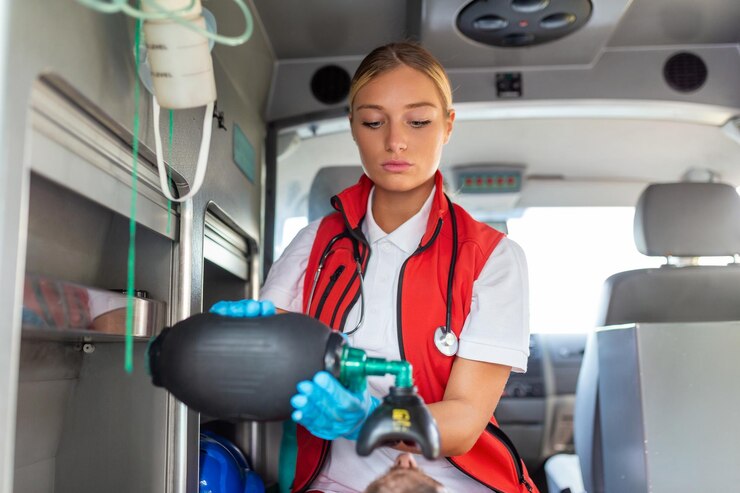
When patients enter multi-organ failure or suffer from critical cardiac or pulmonary collapse, few options exist outside the walls of an ICU. ECMO—Extracorporeal Membrane Oxygenation—has revolutionized care for these patients, taking over the functions of the heart and lungs while they recover. But when such patients need to be transported, especially across long distances, the challenge becomes exponential.
Red Air Ambulance has stepped into this high-risk, high-complexity domain, offering specialized ECMO air transfers throughout India and beyond. From intercity hospital-to-hospital flights to international retrievals, Red Air Ambulance brings the ICU to the skies.
What Makes ECMO Transfers So Complex?
ECMO patients are some of the most unstable cases in modern medicine. They’re often:
- In cardiogenic shock or severe ARDS (acute respiratory distress syndrome)
- Dependent on both ECMO and ventilators
- Supported by multiple infusions and invasive monitoring lines
- Prone to rapid decompensation during movement or altitude change
Every minute of transit introduces risk, and that risk scales with time, altitude, and equipment limitations. Only highly specialized teams and aircraft can deliver these patients safely.
Red Air Ambulance: A Flying ICU for ECMO Transfers
Red Air Ambulance doesn’t merely fly patients—it replicates a full critical care environment aboard its fleet:
- Aircraft retrofitted with advanced ventilators, perfusion pumps, ECMO consoles, and backup power
- In-flight cardiac monitoring and defibrillation equipment
- Continuous sedation, blood gas analysis, and invasive hemodynamic monitoring
Their fixed-wing aircraft (including Learjets and King Air models) are configured to support long-haul ECMO transfers across vast geographies, whether it’s from Shillong to Delhi or Dhaka to Mumbai.
Expert ECMO Retrieval Teams
Red Air Ambulance partners with perfusionists, critical care physicians, ECMO-certified nurses, and respiratory therapists trained to initiate, manage, and troubleshoot ECMO midair. Teams undergo simulation training for in-flight emergencies and use real-time telemedicine consultation during every transfer.
Additionally, Red Air Ambulance liaises directly with both referring and receiving hospitals, ensuring:
- Synchronized handovers
- Precise pre- and post-transport communication
- Proper anticoagulation protocols
- Pre-authorized ICU bed availability
From India to the World: Cross-Border ECMO Transfers
Red Air Ambulance has conducted ECMO transfers between India and:
- UAE, Oman, and Saudi Arabia
- Nepal, Bangladesh, and Bhutan
- Singapore and Thailand
- UK and Germany via air-ambulance staging hubs
Every cross-border mission involves logistical mastery—from overflight clearances to international ICU coordination and family briefing.
Real-World Example: ECMO Transfer from Ranchi to Hyderabad
A 34-year-old patient with severe ARDS and influenza-related lung failure was on veno-venous ECMO in Ranchi. Local ICU infrastructure was stretched, and he required lung transplant evaluation in Hyderabad.
Red Air Ambulance dispatched a twin-engine aircraft within six hours, along with:
- An ECMO technician
- A cardiac anesthesiologist
- A perfusionist nurse
The patient was airlifted over 1,200 kilometers, maintaining stable oxygenation and hemodynamics during the 3.5-hour flight. On arrival, he was immediately admitted to a transplant-ready ICU.
Protocols That Prioritize Survival
Red Air Ambulance follows a strict set of protocols for ECMO transfers:
- Route optimization based on patient condition and aircraft pressurization
- Onboard backup ECMO systems and oxygen reserves
- Continuous pre-flight assessment and ICU clearance
- Full debrief post-landing for quality assurance
These systems minimize the variables in a scenario where there is almost no margin for error.
Preparing for an ECMO Air Transfer
If you are a hospital administrator, ICU consultant, or caregiver facing a potential ECMO transport, here’s what to do:
- Contact Red Air Ambulance’s 24/7 medical command center.
- Share patient case notes, current ECMO type (veno-arterial or veno-venous), and lab values.
- Coordinate with the receiving hospital for ECMO bed and ICU clearance.
- Let Red Air Ambulance handle route planning, airport clearances, and clinical staffing.
Final Thoughts: When Time and Distance Shouldn’t Determine Survival
ECMO transfers are among the most intricate operations in critical care transport. But with the right systems, aircraft, and expertise, geography doesn’t have to define a patient’s chances. Red ambulance brings not just mobility, but possibility. It redefines what can be done in the air, for patients who would otherwise have no chance to reach the right treatment in time.
Whether it’s 300 kilometers or 3,000, Red Air Ambulance delivers ECMO to anywhere—because survival shouldn’t depend on location.




